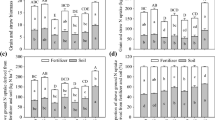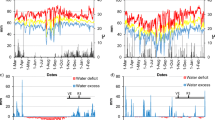Abstract
We studied the effects of 15N-labelled ammonium nitrate and urea on the yield and uptake of labelled and unlabelled N by wheat (Triticum aestivum L., cv. Mexi-Pak-65) in a field experiment. The dry matter and N yields were significantly increased with fertilizer N application compared to those from unfertilized soil. The wheat crop used 33.6–51.5 and 30.5–40.9% of the N from ammonium nitrate and urea, respectively. Splitting the fertilizer N application had a significant effect on the uptake of fertilizer N by the wheat. The fertilizer N uptake showed that ammonium nitrate was a more available source of N for wheat than urea. The effective use of fertilizer N (ratio of fertilizer N in grain to fertilizer N in whole plant) was statistically similar for the two N fertilizers. The application of fertilizer N increased the uptake of unlabelled soil N by wheat, a result attributed to a positive added N interaction, which varied according to the fertilizer N split; six split applications gave the highest added N interaction compared to a single application or two split applications for both fertilizers. Ammonium nitrate gave 90.5, 33.5, and 48.5% more added N interaction than urea with one, two, and six split N applications. A values were not significantly correlated with the added N interaction (r=0.557). The observed added N interaction may have been the result of pool substitution, whereby added labelled fertilizer N replaced unlabelled soil N.
Similar content being viewed by others
References
Azam F, Asharaf M, Lodhi A, Sajjad MI (1990) Availability of soil and fertilizer nitrogen to wheat (Triticum aestivum L.). Biol Fert Soils 10:134–138
Azam F, Ashraf M, Lodhi A, Sajjad MI (1992) Fate and interaction with native soil N of ammonium N applied to wetland rice (Oryza sativa L.) grown under saline and non-saline conditions. Biol Fertil Soils 13:102–107
Burns IG (1980) Influence of spatial distribution of nitrate on the uptake of N by plants, review and a model for development of roots. J Soil Sci 31:155–173
Dewis J, Freites F (1970) Physical and chemical methods of soil and water analysis. Soil Bull No 10, FAO-UN, Rome, pp 51–161
Gok M, Ottow JCG (1988) Effect of cellulose and straw incorporation in soil on total denitrification and nitrogen immobilization at initially aerobic and permanent anaerobic conditions. Biol Fertil Soils 5:317–322
Hamid A, Ahmad M (1987) Ammonia volatilization losses from nitrogen fertilizers in alluvial alkaline soils. Pak J Agric Sci 24:129–139
Hart PBS, Rayner JH, Jenkinson DS (1986) Influence of pool substitution on the interpretation of fertilizer experiments with 15N. J Soil Sci 37:389–403
Hassan MA (1972) Detailed soil survey of Punjab Agricultural Research Institute, Lyallpur, Directorate of Soil Survey W Pakistan, pp 47–49
Hauck RD, Bremner JM (1976) Use of tracers for soil nitrogen research. Adv Agron 28:219–266
Jenkinson DS, Fox RH, Rayner JA (1985) Interaction between fertilizer and soil nitrogen: The so-called priming effect. J Soil Sci 36:425–444
Olsen SR, Sommers LE (1982) Phosphorus. In: Page AL, Miller RH, Keeney DR (eds) Methods of soil analysis. II. Chemical and microbiological properties, 2nd edn. Am Soc Agron Mongr 10, Madison, Wis, pp 420–422
Ottow JCG, Fabig W (1985) Influence of oxygen aeration on denitrification and redox level in different bacterial batch cultures. In: Caldwell DE, Brierley JA, Brierley CL (eds) Planetary ecology. Van Nostrand — Reinhold, New York, pp 427–440
Recous S, Machet JM, Mary B (1988) The fate of labelled 15N urea and ammonium nitrate applied to a winter wheat crop. Plant and Soil 112:215–224
Riga A, Fischer V, Van Praag HJ (1980) Fate of fertilizer nitrogen applied to winter wheat as Na 15NO3 and (15NH4)2SO4 studies in microplots through a four course rotation: 1. Influence of fertilizer spliting on soil and fertilizer nitrogen. Soil Sci 130:88–99
Sörenson LH (1982) Mineralization of organically bound nitrogen in soil as influenced by plant growth and fertilization. Plant and Soil 65:51–61
Wickramasinghe KN, Rodgers GA, Jenkinson DS (1985) Transformations of nitrogen fertilizers in soil. Soil Biol Biochem 17:625–630
Woods LE, Cole CV, Porter LK, Coleman DC (1987) Transformation of added and indigenous nitrogen in gnotoblastic soil: A comment on the priming effect. Soil Biol Biochem 19:673–678
Author information
Authors and Affiliations
Rights and permissions
About this article
Cite this article
Hamid, A., Ahmad, M. Effects of 15N-labelled ammonium nitrate and urea on soil nitrogen during growth of wheat (Triticum aestivum L.) under field conditions. Biol Fertil Soils 17, 232–236 (1994). https://doi.org/10.1007/BF00336328
Received:
Issue Date:
DOI: https://doi.org/10.1007/BF00336328




